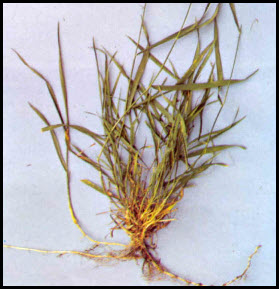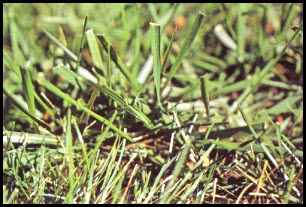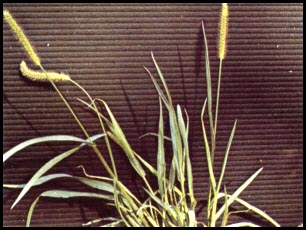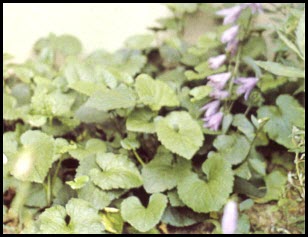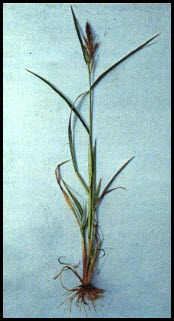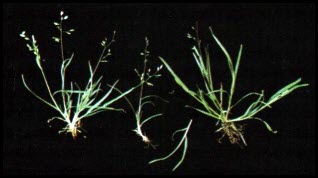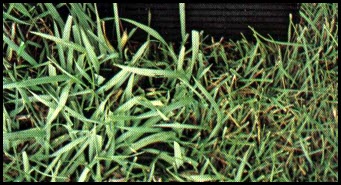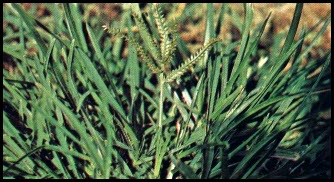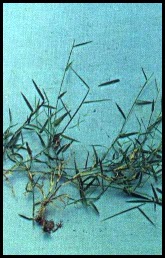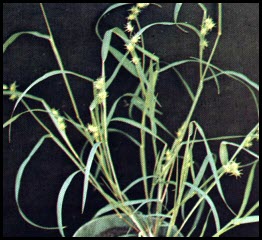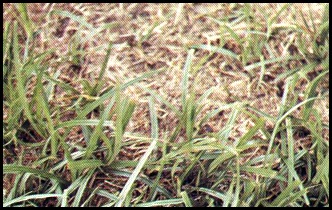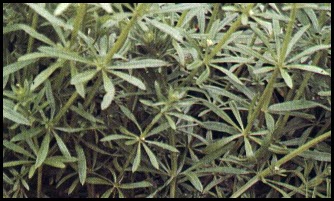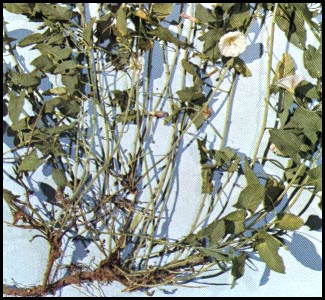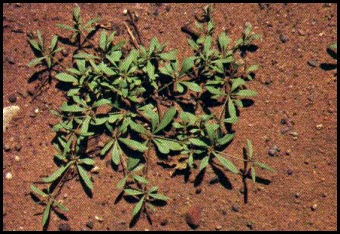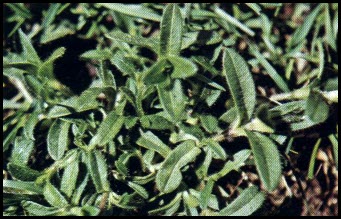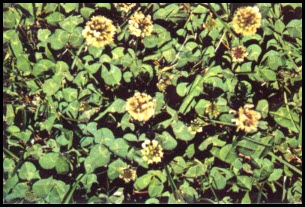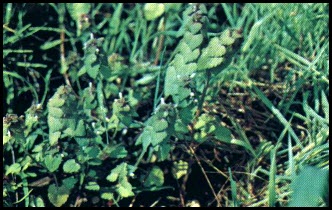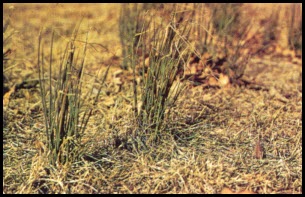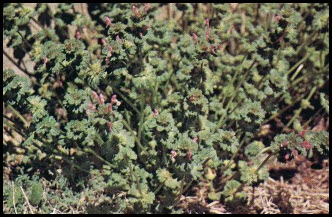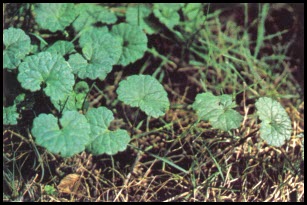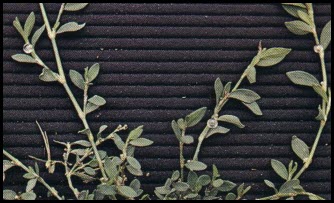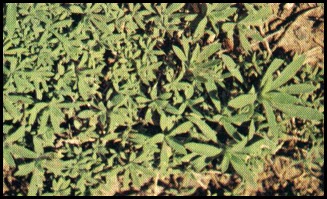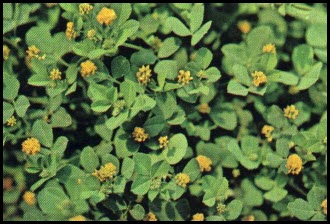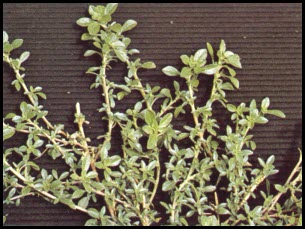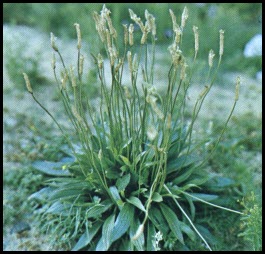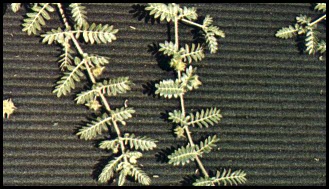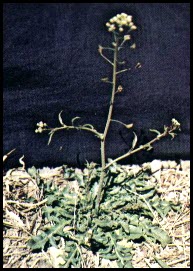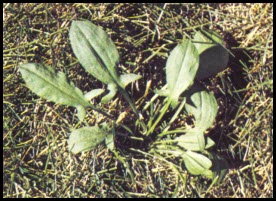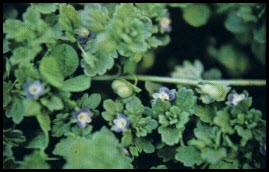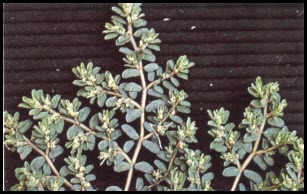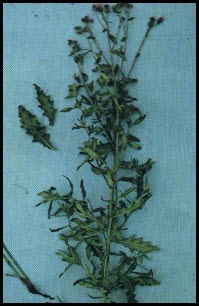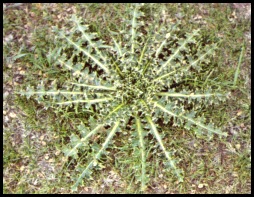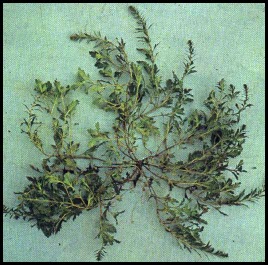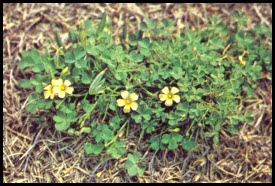
Crabgrass
Crabgrass is one of the most common warm season annual grassy weeds. The stems grow mostly prostrate, branch freely, and send down roots where each joint comes into contact with the soil or moist grass. The sead head is divided into several fingerlike segments. Two principal species are (1) large crabgrass, sometimes known as hairy crabgrass and (2) smooth crabgrass. Smooth crabgrass tends to be smaller, less hairy, and has purplish color on the stems.
Top
Quackgrass
A cool season perennial wheatgrass that speads extensively by long white rhizomes (underground stems.) Leafblades are twice the width of bluegrass and tend to be rough in texture. A claw-like protrusion of the leaf called an auricle clasps the stem. One of the most distinguishing characteristrics is a ring of root hairs every 3/4 to 1 inch along the rhizomes. The lower leaf sheath of the stem is hairy.
Top
Dandelion
Cool season perennials common throughout the region. The yellow flowers occur from early spring to late fall. The thick fleshy taproot, often branched, can give rise to new shoots. Seedlings may appear throughout the spring and summer and are often abundant in the fall.
Top
Fescue, tall
A very coarse cool season perennial bunch grass. Scattered clumps objectionable in fine textured turf grasses. Leaf veins are strongly fibrous. When mowed, fibers show on the cut edge, especially if mower blades are not well sharpened. Mature leaf blades may be one-half inch wide, ribbed above and shiny smooth below. The lower portions of the steams are reddish purple, particularily in the spring and fall. A similar grass, meadow fescue, is a frequent weed in bluegrass lawns.
Top
Foxtail
Foxtails are warm season annuals. Yellow foxtail has flattened stems that are often reddish colored on the lower portions. The stems of green foxtail are round. The seed of yellow foxtail is four times as large as green foxtail. Giant foxtail may be found in some lawns.
Top
Bellflower, creeping
An escape from cultivation that can become a troublesome weed in lawns. The nodding, bell-shaped flowers are showy, ranging from a deep blue to purple. Creeping bellflower is a cool-season perennial with a root system that is both fleshy and fibrous. The basal leaves are heart-shaped with long stems. The leaves on the flower stalks are long and narrow without stems.
Top
Barnyardgrass
A coarse warm season annual grass with a flattened stem especially near the base. Lower portion of the platt tends to be reddish purple. The seed head branches into 6 or 8 short compact segments.
Top
Bluegrass, annual
A low-growing, compact, tufted winter annual. Some flattened stems may lie close to the ground. It does not have rhizomes. Leaves are soft, light-green, and boat-shaped at the tip. Starts growth from seed in early fall and often grows throughout winter. Can produce seed heads when mowed at 1/4". May die suddenly during summer months.
Top
Brome, smooth
A cool season perennial. Many bluegrass lawns that contain smooth brome were started with pasture sod. The leaves are 3/8 to 1/2 inch wide and tend to be lax rather than upright. Close examination of an entire leaf will reveal an "M" or "W" across the leaf blade. The lower portion of the stem is almost white with prominent veins. Smooth brome spreads primarily by underground stems.
Top
Goosegrass
A decidedly warm season annual most often found growing where bluegrass stands are thin. Germinates later than crabgrass. The stems tend to be flattened and near the base are whitish in color. Flower heads are thicker and more robust than on common crabgrass. The extensive fibrous root system makes it difficult to pull.
Top
Nimbleweed
A warm season perennial grass. The wiry fine stems root at the nodes; root system is shallow and fibrous; forms circular patches or may be distributed throughout lawn. Objectionable in bluegrass lawns because of delayed spring growth and early dormancy in the fall.
Top
Sandbur
A warm season annual grass most often found in sandy turf areas that have been on low maintenance programs. Stems are flattened and branched; may be confused with yellow foxtail before formation of the spiny burs.
Top
Nutsedge, yellow
Warm-season perennial. Triangular stems of sedges produce 3-ranked leaves from near the ground. Leaves light yellow-green and rather harsh. Lower portion of plant is fibrous and brown. Roots often terminate with small nutlets, about the size of a kernel of popcorn. Seed heads appear burlike. Plants grow rapidly in July and August. Several species of sedge are common to our region, but this one is most prevalent in lawns.
Top
Bedstraw
Cool season plants, generally annuals, most often found in the dense shade of trees and shrubs. The leaves and leaflike parts form whorls at distinct internals along the weak stems. The square stems have tiny sawtoothed appendages which cause plants to stick together and to clothing. The flowers are small with four white petals.
Top
Bindweed, field
A deep rooted perennial vine that is one of the most difficult weeds to control. The spade-shaped leaves have rounded tips and vary in size. The funnel shaped flowers vary from white to light pink and are about the size of a nickel. The plant readily climbs over shrubs and other ornamentals. It spreads by both seed and roots.
Top
Carpetweed
A late-starting, rapidly growing summer annual. The green, smooth stems branch along the ground in all directions from the root forming a flat circular mat on the soil surface. The light-green, smooth, tongue-like leaves are grouped five to six together forming whorls at each joint on the stem. Flowers are small, white, with several at each joint.
Top
Chickweed, mouseear
A perennial with creeping stems that root at the nodes. The leaves are opposite, 2-3 times longer than wide, clammy, and hairy. Flowers have five white petals. The root system is shallow and fibrous.
Top
Clover, white
A cool season perennial legume that spreads by underground and above ground stems. May or may not be objectionable in lawns, depending on individual preference. Flowers white, sometimes with a tinge of pink. Seeds will live for 20 or more years in the soil.
Top
Deadnettle
A winter annual that starts growth in early fall. Slightly pubescent throughout. The squarish stems may be upright or spreading. Leaves are opposite with scalloped edges. Flowers are purple red.
Top
Dock
Dock seldom flowers when growing in lawns. The plant froms a large rosette. Curly dock is most common and the leaves have crinkled edges. They are often tinted with red or purple color. Pale dock has leaves that tend to be more flat and broad. Both species have flowering stalks that may reach a height of two to three feet.
Top
Garlic, wild
The slender, smooth, leaves are hollow and attached to the lower portion of the waxy stems. Both bulbs and bulblets are produced underground and the green to purple flowers are often replaced with bulblets. There is a characteristic onion-garlic odor. Wild onion is similar to wild garlic, but does not produce underground bulblets and the leaves are not hollow.
Top
Henbit
A winter annual that starts growth in September. Stems are squarish; plants usually upright. Flowers are lavender to blue. Leaves are opposite. A few plants may bloom in the fall, but the majority blossom in early spring.
Top
Ivy, ground
A cool season perennial originally introduced as a ground cover, but is now a weed in many lawns. Thrives in shade, but will also grow in the sun. Ground ivy produces an abundance of lavender to blue funnel-form flowers in early spring. The square stems may root at each joint where they touch the ground.
Top
Knotweed, prostrate
An annual that thrives from early spring to late fall. Germination occurs in very early spring. Grows flat from a long white taproot. Individual plants may have a spread of 2 feet or more. Stems wiry, very leafy; at each leaf node there is a thin papery sheath. Leaves often have a bluish cast. Seeds are three-cornered, light-brown early and shiny black at maturity.
Top
Kochia
A versatile annual capable of adapting itself to a wide variety of environmental conditions. In lawns, it assumes a prostrate habit of growth; if not mowed it may attain a height of 7 or 8 feet. The first leaves after germination are covered with a silvery pubescence. Germination starts in early spring and continues throughout the summer. Leaves and stems vary in color from greenish yellow to greenish red.
Top
Mallow
Common mallow and dwarf mallow are the most prevalent species. The long fleshy taproot is almost white. Flowers are bluish white. The seed portion is a flattened disc which breaks into 10 to 20 pie-shaped segments.
Top
Medic, black
An annual or short lived perennial legume with trailing stems that grow close to the ground. The taproot penetrates deeply into most soils. The three-leaflet leaves have prominent veins and are similar to most other clover leaves. The small clusters of flowers are bright yellow. Seed pods turn almost black at maturity. Black medic is most noticeable in lawns during June, July, and August.
Top
Moss
A primitive form of plant life consisting of many genera and species. Moss prefers an environment that is cool and moist. It is most often found in shaded areas such as the north side of buildings and on poorly drained soil.
Top
Prostrate, pigweed
A warm season prostrate annual that grows from a pink taproot. The leaves are very shiny. Stems smooth, light-green to reddish green, may spread 1 1/2 to 2 feet. Seeds are lens shaped, small, and shiny black.
Top
Plantain, blackseed and broadleaf
Cool season perennials that form rosettes with prominently veined leaves. The leaves of blackseed are oval shaped and 2 to 3 inches across with purplish stalks; broadleaf plantain has smaller leaves without purplish coloration. Both species have rat-tail like seed heads that are several inches long.
Top
Plantain, buckhorn-Perennial
Has slender, narrow leaves that are about one inch across with 3-5 prominent veins. The seed head is a short cylindrical spike.
Top
Puncturevein
A prostrate freely branching warm season annual. Plants slightly hairy. Some stems may be four or five feet long. Taproot. Leaflets bright green. Flowers yellow. Seeds angled, each with 2 stout spines that give a Texas longhorn appearance.
Top
Purslane, common
A warm season annual. Leaves and stems fleshy or succulent, reddish in color. Grows prostrate. Root system tends to be fibrous; stems root wherever they touch the ground, particularly if the main root has been destroyed. Flowers small, yellow. Seeds very small, black.
Top
Shepherdspurse
A winter annual. The deeply lobed leaves form rosettes in the fall that may be confused with dandelions; however, the leaves lack the milky sap. Blooms in very early spring. White flowers develop into triangular seed pods filled with numerous tiny reddish brown seeds.
Top
Sorrel, red
A low growing, cool season perennial that reproduces by creeping roots and seeds. Leaves are spear shaped. The lacy flowering stalks bloom in mid-spring with a definite reddish color. The seed is small, three-sided and reddish brown. Remains green from very early spring to early winter.
Top
Speedwell
Several weedy species exist, most being winter or early spring annuals. Plants very low growing; leaf shapes vary with species but generally are small and numerous; flowers are light blue with white throats. Seed pods are divided and almost heart-shaped.
Top
Spurge, prostrate
A prostrate growing warm season annual. Spotted spurge has hairy stems and leaves with a prominent purple spot on each leaf. Prostrate spurge has hairy stems and leaves but no spots. Most prominent in July, August, and September. Milky sap. Seeds are born in three's in a capsule.
Top
Thistle, Canada - Perennial
May spread by horizontal roots. Leaf form may
vary. Most varieties have dark green spiny lobed leaves with crinkled edges. The lavender flowers are 3/4" or less in diameter.
Top
Thistle, musk
A biennial found in lawns as a rosette. Leaves are free of hair and have a light colored midrib. Leaf margins are usually edged in grey-green. Spiny. Flowers are large, powder puff in shape, and usually deep rose to violet in color.
Top
Vervain prostrate
A warm season annual that may on occasion act as a perennial. Low growing, hairy throughout. Stems branch freely in all directions, forming circular patterns of growth. Leaves vary in size and form, often are wedge-shaped and toothed. Taproot. Small funnel-form flowers are blue to purple.
Top
Cool season perenials that are among the first plants to bloom in the spring. Prefer at least partial shade. Flower color varies from very light blue to deep purple. Occasionally become troublesom in lawns.
Top
Woodsorrel, yellow
Classified as a perennial, but more often performs as a warm season annual. Stems branch from the base. The leaves are palmately divided into three leaflets giving a cloverlike appearance. Funnel-form flowers are yellow. The seed pod is cylindrical, 5-sided, and pointed. The plants contain soluble oxalates which give it a rather pleasing sour taste.
Top
Yarrow, common - Perennial
May grow one to two feet tall. Leaves are soft, finely divided, fern-like. Stems and leaves are covered with grayish-green fine hairs. Flowers are mostly white forming a flat flower-cluster. Entire plant is rather strongly scented.
Top
*Illustrations and descriptions provided by Lawn Weeds and Their Control, North Central Regional, Extension Publication No. 26, 1992.

